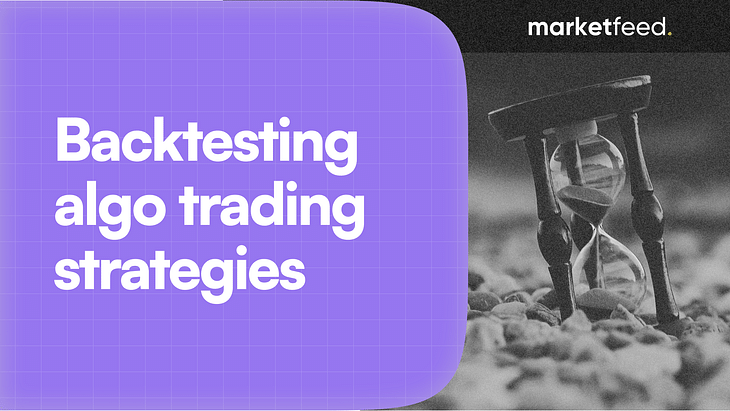Why Should You Backtest Algo Trading Strategies?

In the world of algo trading, where computer programs make lightning-fast decisions based on pre-defined rules and data inputs, it’s important to test and validate your trading strategies thoroughly. This process, known as backtesting, is a vital step every algo trader should devote time to before deploying their strategies in live markets!
But what exactly is backtesting, and why is it so crucial? In this article, we explore the key reasons why you should backtest your algo trading strategies.
What is Backtesting?
Before buying a new car, you wouldn't just hand over your money without taking it for a test ride, right? You would want to see how it accelerates, how comfortable it is, and if it meets your needs.
Similarly, backtesting is a way to "test-drive" your algo trading strategy using historical market data before deploying it with real money in the live markets. It’s like rewinding the clock and watching your strategy play out, trade by trade! This allows you to evaluate factors like:
- How much profit or loss your strategy would have made
- How often it would have made winning or losing trades
- The biggest drawdown (temporary loss) it might have experienced
If the backtesting results are satisfactory, you'll gain more confidence in your strategy, much like a smooth test drive would give you confidence in a car you're thinking of buying. On the other hand, if the backtesting reveals significant flaws, you can make adjustments or even eliminate the strategy altogether.
By backtesting, you can identify the strengths and weaknesses of your strategy before risking any real money. However, backtesting doesn't guarantee future success. It's simply a way to test and refine your strategy using historical data before applying it in the real markets.
Why is it Important to Backtest Algo Trading Strategies?
1. Evaluating the Performance of a Strategy
Imagine you've spent countless hours developing a complex algo trading strategy. But after it went live, you find out that it's not delivering the results you hoped for! 😔 Backtesting allows you to analyse & assess the historical performance of your strategy under various market conditions.
For example, let's say you've created a specific strategy for trading the Nifty 50 index. By backtesting this strategy on historical Nifty data, you can see how it would have performed during different market cycles, such as bull runs, bear markets, and periods of high volatility. This insight can help you measure the strategy's strength and make informed decisions about when and how to deploy it.
2. Risk Management
Risk management is an important aspect of successful algo trading, and backtesting plays a big role in this process. By simulating your strategy's performance on historical data, you can evaluate its potential risks, such as maximum drawdowns, win/loss ratios, and other risk metrics.
[A drawdown is a temporary decline or loss in the value of a trading account from its peak level before it recovers or reaches a new high.]
With this information, you can adjust your position sizing, implement stop-loss rules, or refine your risk management parameters to mitigate potential losses. For example, if your backtesting reveals that your strategy experiences occasional large drawdowns, you might consider implementing a trailing stop-loss to protect your gains or reducing your position size to limit your risk exposure.
3. Optimising Strategies
Backtesting is not only about evaluating the performance of your current trading strategy; it's also a chance to refine and improve your approach. By running simulations with various conditions, you can identify the conditions/settings that provide the best results in terms of profitability, risk-adjusted returns, or other performance metrics.
Suppose your initial strategy has a rule to buy a stock when its price drops 5% from its peak. After backtesting, you find that adjusting this threshold to 3% or 7% might yield better results. By experimenting with different parameters, you can identify the most effective settings for your strategy.
4. Building Confidence
Algo trading can be a rollercoaster ride, with periods of significant profits 🤑 followed by drawdowns or losses 🤕. Backtesting provides evidence of your strategy's effectiveness. As a trader, it'll give you confidence to stick with your approach during challenging times.
When you've carefully tested your strategy and seen it perform well across various market conditions, you'll have a stronger belief in its validity. This confidence can help you resist the temptation to abandon your strategy prematurely or make impulsive decisions based on emotions, which can often lead to poor outcomes.
5. Continuous Improvement
Backtesting is not a one-time exercise. It's an ongoing process that allows you to continuously monitor, evaluate, and refine your algo trading strategies. As markets evolve and new data becomes available, you can incorporate this information into your backtesting process. This will help you to adapt and improve your strategies accordingly.
For example, suppose a major economic event or regulatory change significantly impacts market behaviour. In that case, you can backtest your strategies against this new data to assess their performance and make necessary adjustments. This approach ensures that your strategies remain relevant and effective in the ever-changing financial markets.
6. Diversification
We always advise our dear readers to maintain a diverse portfolio of investments to reduce overall risk. The same principle applies to algo trading strategies. Instead of relying on a single strategy, it's better to have multiple strategies that operate differently (just like having a mix of different investments!)
Backtesting makes it possible to evaluate and optimise several algo trading strategies simultaneously, allowing you to build a well-diversified trading portfolio. By evaluating these strategies through backtesting, you can identify their strengths and weaknesses. You could also pinpoint the specific market conditions where each strategy tends to perform well or poorly.
7. Regulatory Compliance
As algo trading has become more prevalent in financial markets, stock market regulators like the Securities and Exchange Board of India (SEBI) have started paying closer attention to it. Their main concern is to ensure that algo trading systems are fair, transparent, and don't cause any unintended harm or disruption to the markets.
Most regulators insist traders and firms backtest their algorithmic trading strategies as part of the development and deployment process.
Conclusion
Backtesting is a crucial step in the development and deployment of successful algo trading strategies. By testing your strategies against historical data, you can evaluate their performance, manage risks, optimise parameters (conditions), build confidence, and continuously improve your approaches.
While backtesting is essential, it's important to remember that past performance is not a guarantee of future results. Market conditions can change, and unforeseen events can occur. However, by combining backtesting with strong risk management practices, continuous monitoring, and a disciplined approach, you can increase your chances of success in the dynamic world of algo trading.
So take the time to backtest algo trading strategies thoroughly before you unleash them into the markets. It's a small investment of effort that can yield significant returns in terms of improved performance, risk mitigation, and overall trading success!
Also read: Is Algo Trading Legal in India?


Post your comment
No comments to display